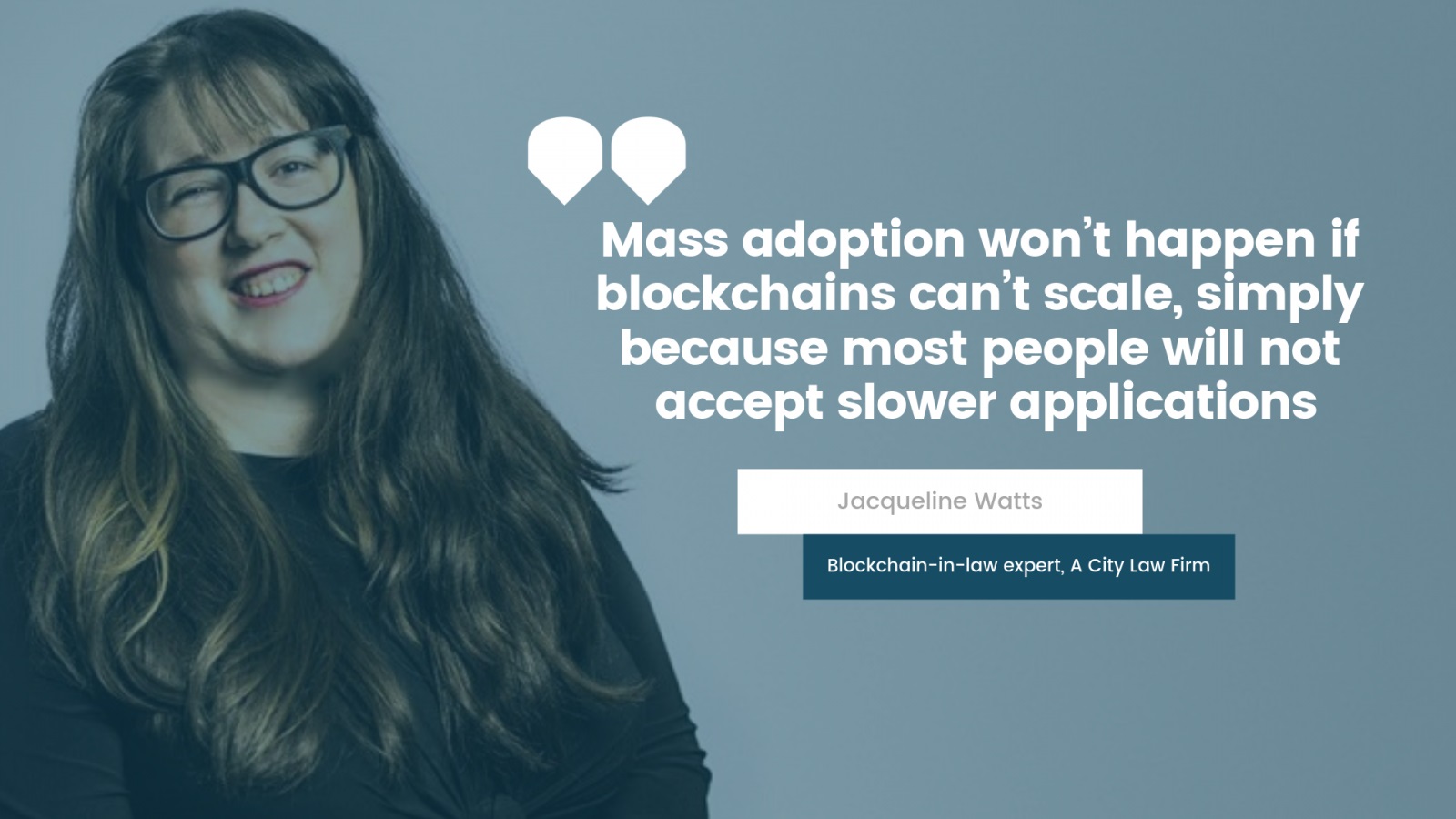
THE SCALABILITY CHALLENGE
“Mass adoption won’t happen if blockchains can’t scale, simply because most people will not accept slower applications. Blockchain was not initially designed with the widespread use and the number and different types of adaptation now in mind. As the number of daily transactions continues to rise, an increasing number of issues are popping up especially with regards to the potential speed in which transactions can be processed,” Jacqueline Watts, blockchain-in-law expert, A City Law Firm.
“In general, blockchains by their nature are affected by a tradeoff between security, decentralisation and scalability. Only two of these three attributes can be prioritised; the other sacrificed. This is why open public blockchains such as Bitcoin and Ethereum – which were designed to focus on decentralisation and network security – suffer from relatively low transaction processing speeds compared to the likes of Visa or Mastercard, whilst consortium blockchains have higher speeds but at the cost of centralisation.

Because of the decentralised model, some blockchains, including Bitcoin, are difficult to upgrade to add new scalability features, without either a) generating very strong consensus between existing participants, or b) disagreement between factions causing a split – otherwise known as a fork – that creates a new blockchain altogether, one with the upgraded features and one without,” Andy Bryant, COO at bitFlyer Europe.
“One of the practical constraints for enterprise scalability is privacy control. While permissioned blockchains are great at controlling access to online applications and documents, most blockchains lack the ability to control what specific fields of data are or are not accessible to different authorised users. Stated differently, all permissioned users should not necessarily have access and visibility to all of the data. Various industry forums and blockchain technology providers have begun looking at options to address this need, but most come with concerns about scaling complexity, and operational performance as utilisation grows,” Frank Wiener, CMO, Sepior Aps.

THE INTEROPERABILITY CHALLENGE
“Blockchain interoperability is another key issue. Following up on the scale concern over privacy control, imagine how difficult it will be to achieve blockchain interoperability if privacy control is implemented differently for each blockchain technology. It’s clearly a non-starter to have different approaches for each technology. So technologies which provide a bridge between different implementations, or better yet technologies which natively work off-chain across different blockchain platforms, will go a long way in achieving interoperability,” Frank Wiener.
“From a legal perspective, whenever there is multiple party involvement there is an increased risk of litigation, as each party, without doubt, seeks to blame the other. It is essential from the outset that roles and responsibilities are clearly mapped out and that all parties clearly agree on the intellectual property right ownership in the new solution. It is vital that developers agree who is responsible for each part of the solution, especially if something goes wrong. Developers should ensure they enter into a properly considered joint venture agreement which reflects the complexities of the arrangement,” Jacqueline Watts.
“In my opinion, Accenture’s solution proposal that enables integration between different blockchain platforms by introducing standards that different platforms agree upon, and allowing the transfer of tokenised assets on these platforms, is huge. It would allow interoperability between different platforms and would make building business that uses blockchain easier and less risky. New blockchains appear quite often, some of them get traction and user base, some of them lose it.
If you’re making a business on a specific blockchain right now, you’re making a bet. In case your blockchain of choice becomes less popular, less effective, or a new one that is much better appears on the horizon, you will need to switch at some point. Right now it’s a painful and expensive process. The solution that Accenture proposes makes such moves a lot easier,” Vladimir Tomko, CEO and game producer of Blockchain Cuties.
THE MAINSTREAM CHALLENGE
“It’s only a matter of time until the march towards mainstream picks up and I think 2019 could be the tipping point. If we look at the definition of ‘mainstream’ from a value perspective, I’d argue blockchain is catching up with the other large payment processing companies. Where it’s lagging behind is volume. However, there are other challenges facing blockchain. The model is also facing resistance from incumbents, misinformation causing negative publicity, regulatory apprehensiveness and a basic lack of awareness of its transformational potential. Much more education is needed to introduce blockchain to the day-to-day. But looking back 25 years, we would have said exactly the same for mass adoption of the internet,” Andy Bryant.
“Permissioned blockchains used for enterprise applications will go through a period of ongoing and sustained innovation rather than a single event. There are too many knobs and variables to have one solution address all of the constraints. But it will be refined and proven on use cases where it can add compelling value, with only a moderate degree of technology complexity. As it becomes more established and systems align to more natively work with blockchain, the scope and complexity of projects will expand. I expect that the various constraints will be addressed in parallel, resulting in moderate adoption for select use cases within three years and more mainstream adoption within five-plus years,” Frank Wiener.

“It is clear that blockchain has definite disruptive potential, but it is currently at a very immature stage. It will need to evolve through several more stages before it becomes a useful tool for enterprises and consumers. For this evolution to take place, and blockchain to become commercially viable, enterprises and organisations need to fundamentally change the way corporate IT is delivered.
This means moving away from hardware, and embracing software. This new paradigm doesn’t mean the need for reliable and secure infrastructure disappears. In fact, the more distributed the application, the more important the network and underlying infrastructure becomes,” Craig Tavares, Director of Product Innovation and Technology at Cogeco Peer 1.


